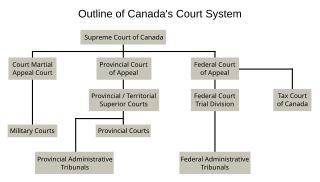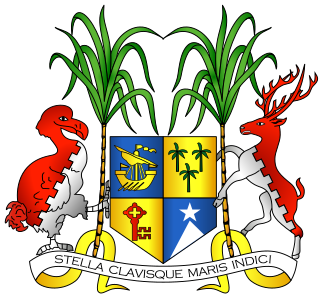Related Research Articles

A court is any person or institution with authority to judge or adjudicate, often as a government institution, with the authority to adjudicate legal disputes between parties and carry out the administration of justice in civil, criminal, and administrative matters in accordance with the rule of law. In both common law and civil law legal systems, courts are the central means for dispute resolution, and it is generally understood that all people have an ability to bring their claims before a court. Similarly, the rights of those accused of a crime include the right to present a defense before a court.
The Supreme Court of the State of New York is the trial-level court of general jurisdiction in the New York State Unified Court System. It is vested with unlimited civil and criminal jurisdiction, although outside New York City it acts primarily as a court of civil jurisdiction, with most criminal matters handled in County Court.
In common law systems, a superior court is a court of general competence which typically has unlimited jurisdiction with regard to civil and criminal legal cases. A superior court is "superior" relative to a court with limited jurisdiction, which is restricted to civil cases involving monetary amounts with a specific limit, or criminal cases involving offenses of a less serious nature. A superior court may hear appeals from lower courts.

District courts are a category of courts which exists in several nations, some call them "small case court" usually as the lowest level of the hierarchy. These include:

The court system of Canada forms the judicial branch of government, formally known as "The Queen on the Bench", which interprets the law and is made up of many courts differing in levels of legal superiority and separated by jurisdiction. Some of the courts are federal in nature, while others are provincial or territorial.

The judicial system of Turkey is defined by Articles 138 to 160 of the 1982 Constitution. Civilian and military jurisdiction are separated. While military courts usually only try military personnel, they can also try civilians in times of martial law and in matters concerning military service.

The law of Brazil is based on statutes and, partly and more recently, a mechanism called súmulas vinculantes. It derives mainly from the civil law systems of European countries, particularly Portugal, the Napoleonic Code and the Germanic law.

The supreme court is the highest court within the hierarchy of courts in many legal jurisdictions. Other descriptions for such courts include court of last resort, apex court, and highcourt of appeal. Broadly speaking, the decisions of a supreme court are not subject to further review by any other court. Supreme courts typically function primarily as appellate courts, hearing appeals from decisions of lower trial courts, or from intermediate-level appellate courts.

The judiciary of Pakistan is a hierarchical system with two classes of courts: the superior judiciary and the subordinate judiciary. The superior judiciary is composed of the Supreme Court of Pakistan, the Federal Shariat Court and five High Courts, with the Supreme Court at the apex. There is a High Court for each of the four provinces as well as a High Court for the Islamabad Capital Territory. The Constitution of Pakistan entrusts the superior judiciary with the obligation to preserve, protect and defend the constitution. Neither the Supreme Court nor a High Court may exercise jurisdiction in relation to Tribal Areas, except otherwise provided for. The disputed regions of Azad Kashmir and Gilgit–Baltistan have separate court systems.

The Supreme Court of Justice is the highest judicial court in Peru. Its jurisdiction extends over the entire territory of the nation. It is headquartered in the Palace of Justice in Lima.

The Superior Courts of Justice or Superior Sectors of Peru are the second highest courts of the Judicial System of Peru. It is only second to the Supreme Court. There is one court for each Judicial District which more or less correspond with each of the 25 Regions of Peru. A Superior Court is subdivided into smaller courts according to its speciality:

The judiciary of Peru is a branch of the government of Peru that interprets and applies the laws of Peru to ensure equal justice under law and provide a mechanism for dispute resolution.
The Judicial District of Cono Norte is one of the 28 Judicial Districts of the Judicial System of Peru.

The Courts of First Instance are the third hierarchic level organized in the Judicial System of Peru.
The Judiciary of Vermont is the state court system of Vermont, charged with Vermont law.

The Judiciary of Spain consists of Courts and Tribunals, composed of judges and magistrates (Justices), who have the power to administer justice in the name of the King of Spain.

The Judiciary of Brazil is the judiciary branch of the Brazilian government. The structure and the division of jurisdiction between the divisions of the Brazilian judiciary is defined in the Brazilian Constitution.

The Supreme Court of Mauritius is the highest court of Mauritius and is the final court of appeal in the Mauritian judicial system. It was established in its current form in 1850, replacing the Cour d'Appel established in 1808 during the French administration and has a permanent seat in Port Louis. There is a right of appeal from the Supreme Court of Mauritius directly to the Judicial Committee of the Privy Council in London.

The Superior Courts of Justice, or High Courts of Justice, are courts within the judicial system of Spain, whose territorial scope covers an Autonomous Community, as laid down in the Organic Law of Judicial Power.

The Judiciary of Sierra Leone is the branch of the Government of the Republic of Sierra Leone which interprets and applies the laws of Sierra Leone to ensure impartial justice under law and to provide a mechanism for dispute resolution. The independence of the judiciary is guaranteed by the constitution.
References
- ↑ (in Spanish) Judicial Power of Peru. Superior Court of Justice Lima Archived 2008-12-11 at the Wayback Machine . Retrieved 3 December 2008.
- ↑ (in Spanish) Judicial Power of Peru. Superior Court of Justice North Lima Archived 2008-12-01 at the Wayback Machine . Retrieved 3 December 2008.